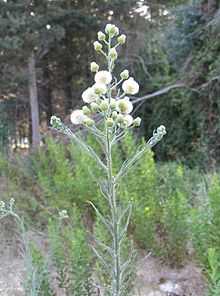Conyza
- Not to be confused with Cichorium intybus - more commonly called "chicory", but also sometimes called "horseweed"
| Conyza | |
|---|---|
 | |
| Conyza bonariensis | |
| Scientific classification | |
| Kingdom: | Plantae |
| (unranked): | Angiosperms |
| (unranked): | Eudicots |
| (unranked): | Asterids |
| Order: | Asterales |
| Family: | Asteraceae |
| Tribe: | Astereae |
| Genus: | Conyza Less., 1832 |
| Species | |
|
See text | |
Conyza (horseweed, butterweed or fleabane) is a genus of about 50 species of flowering plants in the family Asteraceae, native to tropical and warm temperate regions throughout the world, and also north into cool temperate regions in North America and eastern Asia. The genus is closely related to Erigeron (also known as fleabanes).
The species are annual or perennial herbaceous plants, rarely shrubs, growing to 1-2 m tall. The stems are erect, branched, with alternate leaves. The flowers are produced in inflorescences, with several inflorescences loosely clustered on each stem.
Many plant species of the Conyza genus are ruderal species and some have been found to be resistant to the herbicide glyphosate, in some cases.[1]

Selected species
The native range of each species is given; some are introduced elsewhere in the world.
- Conyza aegyptiaca. Africa, southern Asia.
- Conyza ageratoides. Madagascar.
- Conyza blinii. China.
- Conyza bonariensis. Pantropical.
- Conyza canadensis. North and Central America.
- Conyza japonica. Eastern Asia.
- Conyza laevigata. Mexico, Central and South America
- Conyza leucantha. Southern Asia, northern Australia.
- Conyza muliensis. China.
- Conyza perennis. China.
- Conyza stricta. China.
- Conyza primulifolia. Mexico, Central and South America.
- Conyza sumatrensis. North America (despite the Latin name, not Sumatra).
- Conyza ramosissima
References
- ↑ Zelaya, I. A.; Owen, M. D. K.; Vangessel, M. J. (2007), "Transfer of glyphosate resistance: evidence of hybridization in Conyza (Asteraceae)", American Journal of Botany 94 (4): 660–73, doi:10.3732/ajb.94.4.660, PMID 21636434